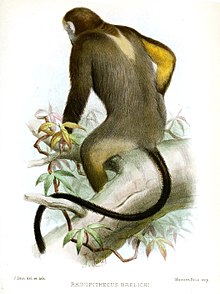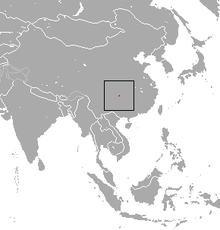Gray snub-nosed monkey
| Gray snub-nosed monkey | |
|---|---|
 |
|
| Scientific classification | |
| Kingdom: | Animalia |
| Phylum: | Chordata |
| Class: | Mammalia |
| Order: | Primates |
| Family: | Cercopithecidae |
| Genus: | Rhinopithecus |
| Species: | R. brelichi |
| Binomial name | |
|
Rhinopithecus brelichi Thomas, 1903 |
|
 |
|
| Gray snub-nosed monkey range | |
| Synonyms | |
|
Pygathrix brelichi |
|
Pygathrix brelichi
The gray snub-nosed monkey (Rhinopithecus brelichi), also known as Brelich's snub-nosed monkey, Guizhou snub-nosed monkey, and Guizhou golden monkey, is a species of primate in the family Cercopithecidae. It is endemic to China, where it is known as the Guizhou golden hair monkey (黔金丝猴) or gray golden hair monkey (灰金丝猴). It is threatened by habitat loss. Of the three species of snub-nosed monkeys in China, the gray snub-nosed monkey is the most threatened, with a total population of less than 750 in around 20 groups surviving in the wild.
Adults are covered with long, fine hair, generally grading from brown on its upper body to gray on its lower body, with a white patch between its shoulder blades. Its head, neck, and ends of its limbs are black, except for a golden brow. It has a golden chest, and chestnut fur on its inner knees and inner sides of its upper arms. Its face is bare bluish-white skin, pink around the eyes and mouth, and has a shelf-like brow and reduced nasal bones, giving it a snub-nosed appearance. Juveniles are shades of gray with patterns changing with age. Adult males are brighter colored than adult females, and have white skin on prominent nipples. Size data is limited, but two adult male specimens weighed 14.5 kg on average, and an adult female specimen weighed 8 kg, with adult length excluding tail ranging from 64–73 cm, and tail length ranging from 70–97 cm.
The confirmed distribution range of the gray snub-nosed monkey is limited to the Mount Fanjing National Nature Reserve in the Wuling Mountains in Guizhou province, China. There is unpublished evidence that 20 individuals moved from the Nature Reserve to an adjacent community forest (Lijiadashan), and there are unconfirmed anecdotal reports of a population in Jinfoshan Nature Reserve.
Its habitat consists of mixed deciduous and evergreen broad leaf forest, including secondary forest, but not coniferous forest. The forests include mono-groves of Asian oak (Cyclobalanopsis spp.) and beech (Fagus longipetiolata), as well as mixed species forests that include cherry (Prunus spp.), maple (Acer spp.), Rhododendron spp, and birch (Betula spp.) trees. It lives at elevations of 1,400–2,300 m in summers down to 570 m at times of heavy snow cover. They're thought to utilize most of the available range of the nature reserve. The yearly rainfall in the area above 1,600 m elevation is above 2000 mm. Snow is common in the winter, with sub-freezing temperatures about five months of the year, though monthly mean temperatures are never below 0 °C.
...
Wikipedia

